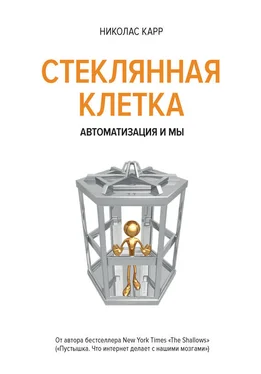20. John D. Lee. Human Factors and Ergonomics in Automation Design / Handbook of Human Factors and Ergonomics / Ed. Gavriel Salvendy. 3rd ed. Hoboken, N.J.: Wiley, 2006. Р. 1571.
21. Еще об ориентированной на человека автоматизации см.: Charles E. Billings. Aviation Automation: The Search for a Human-Centered Approach. Mahwah, N.J.: Lawrence Erlbaum Associates, 1997; Raja Parasuraman et al. A Model for Types and Levels of Human Interaction with Automation // IEEE Transactions on Systems, Man, and Cybernetics 30, 2000. № 3. Р. 286–297.
22. David B. Kaber et al. On the Design of Adaptive Automation for Complex Systems // International Journal of Cognitive Ergonomics 5, 2001. № 1. Р. 37–57.
23. Mark W. Scerbo. Adaptive Automation В книге: Neuroergonomics: The Brain at Work / Eds. Raja Parasuraman and Matthew Rizzo. N. Y.: Oxford University Press, 2007. Р. 239–252. См. также: Mark St. John et al . Overview of the DARPA Augmented Cognition Technical Integration Experiment // International Journal of Human-Computer Interaction 17, 2004. № 2. Р. 131–149.
24. Lee. Human Factors and Ergonomics.
25. Интервью Раджа Парасурамана автору от 18 декабря 2011 года.
26. Lee. Human Factors and Ergonomics.
27. Интервью Бена Трейнела автору от 13 июня 2013 года.
28. Mark D. Gross and Ellen Yi-Luen Do . Ambiguous Intentions: A Paperlike Interface for Creative Design // Proceedings of the ACM Symposium on User Interface Software and Technology. N. Y.: ACM, 1996. Р. 183–192.
29. Julie Dorsey et al. The Mental Canvas: A Tool for Conceptual Architectural Design and Analysis // Proceedings of the Pacific Conference on Computer Graphics and Applications, 2007. Р. 201–210.
30. William Langewiesche. Fly by Wire: The Geese, the Glide, the “Miracle” on the Hudson. N. Y.: Farrar, Straus & Giroux, 2009. Р. 102.
31. Lee . Human Factors and Ergonomics.
32. CBS News. Faulty Data Misled Pilots in ’09 Air France Crash. 2012. July 5. UPL: http://www. cbsnews.com/8301–505263_162–57466644/faulty-datamisledpilots-in-09-air-france-crash/.
33. Langewiesche . Fly by Wire. Р. 109.
34. Federal Aviation Administration. NextGen Air Traffic Control/Technical Operations Human Factors (Controller Efficiency & Air Ground Integration) Research and Development Plan. 2011. version one, April.
35. Nathaniel Popper. Bank Gains by Putting Brakes on Traders // New York Times, 2013. June 26.
36. Thomas P. Hughes. Technological Momentum. В книге: Does Technology Drive History? The Dilemma of Technological Determinism / Eds. Merritt Roe Smith and Leo Marx. Cambridge, Mass.: MIT Press, 1994. Р. 101–113.
37. Gordon Baxter and John Cartlidge. Flying by the Seat of Their Pants: What Can High Frequency Trading Learn from Aviation? / ATACCS-2013: Proceedings of the 3rd International Conference on Application and Theory of Automation in Command and Control Systems / Eds. G. Brat et al. N. Y.: ACM, 2013. Р. 64–73.
38. David F. Noble. Forces of Production: A Social History of Industrial Automation. N.Y.: Alfred A. Knopf, 1984. Р. 144–145.
39. Там же. P. 94.
40. Цитируется по: Noble. Forces of Production. Р. 94.
41. Там же. P. 326.
42. Дайсон высказывает это утверждение в снятом в 1981 году документальном фильме. The Day after Trinity. Цитируется по статье: Bill Joy . Why the Future Doesn’t Need Us // Wired, 2000. April.
43. Matt Richtel . A Silicon Valley School That Doesn’t Compute // New York Times, 2011. October 23.
Интерлюдия. Грабитель могил
1. Peter Merholz. Frictionless’ as an Alternative to ‘Simplicity’ in Design,” Adaptive Path (blog), 2010. July 21. UPL: http://www. adaptivepath.com/ideas/friction-asan-alternative-to-simplicity-in-design.
2. David J. Hill. Exclusive Interview with Ray Kurzweil on Future AI Project at Google // SingularityHUB , 2013. January 10. UPL: http://www. singularityhub.com/2013/01/10/exclusive-interview-with-ray-kurzweil-on-future-aiproject-at-google/.
Глава восьмая. Ваш внутренний робот
1. Азимовские правила поведения роботов (три правила, намертво встроенные в позитронный мозг роботов) впервые появились в опубликованном в 1942 году рассказе «Хоровод», включенном в сборник «Я – робот». N. Y.: Bantam, 2004. Р. 37.
2. Gary Marcus. MoralMachines // New Yorker, 2012. November 27. UPL: http://www. newyorker.com/online/blogs/newsdesk/2012/11/google-driverless-car-morality.html.
3. Charles T. Rubin. Machine Morality and Human Responsibility // New Atlantis, 2011. Summer.
4. Christof Heyns. Report of the Special Rapporteur on Extrajudicial, Summary or Arbitrary Executions. Presentation to the Human Rights Council of the United Nations General Assembly, 2013. April 9. UPL: http://www.ohchr.org/Documents/HRBodies/HRCouncil/RegularSession/Session23/A-HRC-23–47_en.pdf.
5. Patrick Lin et al. Autonomous Military Robotics: Risk, Ethics, and Design, version 1.0.9, prepared for U. S. Department of Navy, Office of Naval Research, 2008. December 20.
6. Там же.
7. Thomas K. Adams. Future Warfare and the Decline of Human Decisionmaking //Parameters, 2001–2002. Winter.
8. Heyns. Report of the Special Rapporteur.
9. Там же.
10. Joseph Weizenbaum. Computer Power and Human Reason: From Judgment to Calculation. N. Y.: W. H. Freeman, 1976. Р. 20.
11. Mark Weiser. The Computer for the 21st Century // Scientific American, 1991. September.
12. Mark Weiser and John Seely Brown. The Coming Age of Calm Technology. Beyond Calculation: The Next Fifty Years of Computing / Eds. P. J. Denning and R. M. Metcalfe. N. Y.: 1997. Springer, Р. 75–86.
13. M. Weiser et al. The Origins of Ubiquitous Computing Research at PARC in the Late 1980s // IBM Systems Journal 38, 1999. № 4. Р. 693–696.
14. См.: Nicholas Carr . The Big Switch: Rewiring the World, from Edison to Google. N.Y.: W. W. Norton, 2008.
15. Thomas P. Hughes. Networks of Power: Electrification in Western Society, 1880–1930. Baltimore: Johns Hopkins University Press, 1983. 140.
16. W. Brian Arthur. The Second Economy // McKinsey Quarterly, 2011. October.
17. Там же.
18. Bill Gates. Business @ the Speed of Thought: Using a Digital Nervous System. N. Y.: Warner Books, 1999. Р. 37.
19. Arthur C. Clarke. Profiles of the Future: An Inquiry into the Limits of the Possible. N. Y.: Harper & Row, 1960. Р. 227.
20. Sergey Brin. Why Google Glass? / speech at TED2013, Long Beach, Calif., 2013. February 27. UPL: http://www.youtube.com/watch?v=rie-hPVJ7Sw.
21. Там же.
22. См.: Christopher D. Wickens and Amy L. Alexander. Attentional Tunneling and Task Management in Synthetic Vision Displays // International Journal of Aviation Psychology 19, 2009. № 2. Р. 182–199.
23. Richard F. Haines. A Breakdown in Simultaneous Information Processing. Presbyopia Research: From Molecular Biology to Visual Adaptation / Eds. Gerard Obrecht and Lawrence W. Stark. N. Y.: Plenum Press, 1991. Р. 171–176.
Читать дальше
Конец ознакомительного отрывка
Купить книгу












